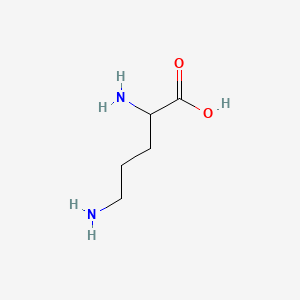| MeSH term | MeSH ID | Detail |
|---|---|---|
| Uremia | D014511 | 33 associated lipids |
| Stomach Ulcer | D013276 | 75 associated lipids |
| Kidney Failure, Chronic | D007676 | 51 associated lipids |
| Diabetes Mellitus | D003920 | 90 associated lipids |
| Adenocarcinoma | D000230 | 166 associated lipids |
| Lupus Erythematosus, Systemic | D008180 | 43 associated lipids |
| Lung Neoplasms | D008175 | 171 associated lipids |
| Wounds and Injuries | D014947 | 20 associated lipids |
| Burns | D002056 | 34 associated lipids |
| Adenoma, Islet Cell | D007516 | 7 associated lipids |
2,5-diaminopentanoic acid
2,5-diaminopentanoic acid is a lipid of Fatty Acyls (FA) class. The involved functions are known as Vasodilation, Intestinal Absorption and Pinocytosis. 2,5-diaminopentanoic acid often locates in Mitochondria, Microfilaments, NADH dehydrogenase complex and respiratory chain complex III location sensu Eukarya. The associated genes with 2,5-diaminopentanoic acid are GAPDH gene and iberiotoxin.
Cross Reference
Introduction
To understand associated biological information of 2,5-diaminopentanoic acid, we collected biological information of abnormalities, associated pathways, cellular/molecular locations, biological functions, related genes/proteins, lipids and common seen animal/experimental models with organized paragraphs from literatures.
What diseases are associated with 2,5-diaminopentanoic acid?
There are no associated biomedical information in the current reference collection.
Possible diseases from mapped MeSH terms on references
We collected disease MeSH terms mapped to the references associated with 2,5-diaminopentanoic acid
PubChem Associated disorders and diseases
What pathways are associated with 2,5-diaminopentanoic acid
There are no associated biomedical information in the current reference collection.
PubChem Biomolecular Interactions and Pathways
Link to PubChem Biomolecular Interactions and PathwaysWhat cellular locations are associated with 2,5-diaminopentanoic acid?
Visualization in cellular structure
Associated locations are in red color. Not associated locations are in black.
Related references are published most in these journals:
| Location | Cross reference | Weighted score | Related literatures |
|---|
What functions are associated with 2,5-diaminopentanoic acid?
Related references are published most in these journals:
| Function | Cross reference | Weighted score | Related literatures |
|---|
What lipids are associated with 2,5-diaminopentanoic acid?
There are no associated biomedical information in the current reference collection.
What genes are associated with 2,5-diaminopentanoic acid?
Related references are published most in these journals:
| Gene | Cross reference | Weighted score | Related literatures |
|---|
What common seen animal models are associated with 2,5-diaminopentanoic acid?
There are no associated biomedical information in the current reference collection.
NCBI Entrez Crosslinks
All references with 2,5-diaminopentanoic acid
Download all related citations| Authors | Title | Published | Journal | PubMed Link |
|---|---|---|---|---|
| pmid: | ||||
| Lemieux B et al. | Amino acid metabolism in Friedreich's ataxia. | 1976 | Can J Neurol Sci | pmid:1000424 |
| Weathers PJ et al. | Arginine catabolism in Aphanocapsa 6308. | 1978 | Arch. Microbiol. | pmid:100070 |
| Idle JR et al. | The conjugation of arylacetic acids in the pigeon compared with the hen. | 1976 | Biochem. Soc. Trans. | pmid:1001621 |
| Moroder L et al. | [1-Adamanty fluoroformate, a useful reagent in peptide chemistry (author's transl)]. | 1976 | Hoppe-Seyler's Z. Physiol. Chem. | pmid:1002131 |
| Kawai Y et al. | A typical bacterial ornithine-containing lipid Nalpha-(D)-[3-(hexadecanoyloxy)hexadecanoyl]-ornithine is a strong stimulant for macrophages and a useful adjuvant. | 1999 | FEMS Immunol. Med. Microbiol. | pmid:10030549 |
| Borcić O and Straus B | Separation of arginase isoenzymes from human tissues by agar gel electrophoresis. | 1976 | J. Clin. Chem. Clin. Biochem. | pmid:1003114 |
| Hu CA et al. | Molecular enzymology of mammalian Delta1-pyrroline-5-carboxylate synthase. Alternative splice donor utilization generates isoforms with different sensitivity to ornithine inhibition. | 1999 | J. Biol. Chem. | pmid:10037775 |
| Storch KF et al. | Car: a cytoplasmic sensor responsible for arginine chemotaxis in the archaeon Halobacterium salinarum. | 1999 | EMBO J. | pmid:10064582 |
| Guillén M et al. | Reference values of urinary excretion of cystine and dibasic aminoacids: classification of patients with cystinuria in the Valencian Community, Spain. | 1999 | Clin. Biochem. | pmid:10074888 |
